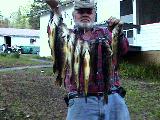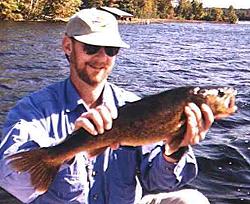|
Fishing Articles
Fishin' the Woodpile
for Walleyes - "An often overlooked tactic"
by John H. Myhre
Fishing in the woodpile? I realize winters can
get rather long and that about now some of you might
tend to think that over the winter I have been sniffing
to much wood smoke. However, let me elaborate. By "woodpile"
I don't mean that stack of cord wood in your back yard
that managed to evade the woodstove over the winter.
What I am really referring to is the drowned wood or
trees you often find commonplace in almost any lake,
river, or stream. During the spring and early summer
period, fishing this drowned wood can often be the key
to consistently catching fish. Yet, not all wood will
attract and hold fish. Learning which wood, when and
how to fish it will often help you to catch not only
more but also bigger fish.
 Differences
in wood; Wood in one form or another is one of the
key fish holding forms of cover on almost any lake,
river, or stream. While it is true that most small stream
anglers commonly fish around drowned wood or down trees,
often this wood is overlooked by anglers on lakes and
even rivers. Probably the most overlooked is the wood
that is in shallow water. Not all shallow wood will
consistently attract and hold fish though. Look for
the most productive down trees, stumps, and logs to
be found in shallow water where there is quick access
to deeper water. If that deeper water also has cover
present in the form of either wood or weeds the adjoining
shallows may be even more productive. On rivers or flowages
these areas are usually located just off the deeper
river channels. In the spring these shallow areas warm
much faster and provide more forage, this in turn draws
more fish of all sizes. Besides the cover and forage
that it provides fish on lakes and flowages, on rivers
and streams wood often provides a current break as well. Differences
in wood; Wood in one form or another is one of the
key fish holding forms of cover on almost any lake,
river, or stream. While it is true that most small stream
anglers commonly fish around drowned wood or down trees,
often this wood is overlooked by anglers on lakes and
even rivers. Probably the most overlooked is the wood
that is in shallow water. Not all shallow wood will
consistently attract and hold fish though. Look for
the most productive down trees, stumps, and logs to
be found in shallow water where there is quick access
to deeper water. If that deeper water also has cover
present in the form of either wood or weeds the adjoining
shallows may be even more productive. On rivers or flowages
these areas are usually located just off the deeper
river channels. In the spring these shallow areas warm
much faster and provide more forage, this in turn draws
more fish of all sizes. Besides the cover and forage
that it provides fish on lakes and flowages, on rivers
and streams wood often provides a current break as well.
Easy fishing vs. tough fishing; Exactly how
you go about catching fish from wood cover depends on
several things. The most important factors are usually
the activity level of the fish, the depth of the wood
cover, and the water temperature. During low light periods
or on stormy overcast days fish tend to be more active
and aggressive. These are the easy times, the times
when the fish are really biting. When you are fishing
for active fish simply retrieving lures over or around
the wood will usually produce strikes. For active fish,
lures that produce plenty of vibration and flash like
a "Beetle Spin" or a rattle type crankbait
are usually your best choice. For a little less aggressive
presentation swimming a simple twist tail grub rigged
on a plain lead jig over the wood works wonders. In
darker water or in low light you want to add a little
more flash to this presentation by using one of the
new "Sizzler Grubs" rigged on a jig. The new
shiny reflective silver coating these grubs have on
the curl tail really increases the flash given off.
 Okay
now that we have discussed catching the easy fish, how
about the times when they just don't seem to be biting?
Things like cold fronts, increased light penetration,
cooler water temperatures, and even increased fishing
pressure can really turn the fish off and make fishing
tough. As fish activity moves away from active toward
inactive they most often tend to hold tighter to cover.
Usually they will still strike a lure or bait but they
just won't chase it. What this means is that you must
put your bait right in their face to get them to take
it. Sounds easy but here's the catch. Wood and fish
hooks don't usually get along to well with each other.
When the fish are holding down in heavy wood cover sometimes
just getting your bait in front of them without snagging
up can seem impossible. Yet there are a few tricks that
will help you effectively fish in heavy wood with very
little snagging up. Okay
now that we have discussed catching the easy fish, how
about the times when they just don't seem to be biting?
Things like cold fronts, increased light penetration,
cooler water temperatures, and even increased fishing
pressure can really turn the fish off and make fishing
tough. As fish activity moves away from active toward
inactive they most often tend to hold tighter to cover.
Usually they will still strike a lure or bait but they
just won't chase it. What this means is that you must
put your bait right in their face to get them to take
it. Sounds easy but here's the catch. Wood and fish
hooks don't usually get along to well with each other.
When the fish are holding down in heavy wood cover sometimes
just getting your bait in front of them without snagging
up can seem impossible. Yet there are a few tricks that
will help you effectively fish in heavy wood with very
little snagging up.
The art of snag free fishing; Fishing in any
heavy cover without snagging up all the time can easily
be done if you approach it as a whole different way
of fishing. Simply tying on a weedless jig or hook will
not keep you from snagging in wood if you are doing
every thing else wrong. Besides using jigs or hooks
that are more snag resistant there are a couple of other
important details you should not overlook. Weight and
line angle. Jig or sinker weight should be kept to a
minimum, use only as much weight as necessary. Excess
weight causes the bait to drop quickly into cracks and
crevasses in the wood where it can become wedged. Line
angle can also contribute to snagging due to wedging.
When fishing wood you should always try to keep your
casts very short and work close to the boat. This keeps
your line angle closer to vertical and your bait more
snag free.
 Snag
free rigging; When fishing less active fish in shallow
wood cover one of the most productive presentations
is simply flipping a small weedless jig or a weedless
hook tipped with live bait into the wood and slowly
swimming it back out. You should concentrate on keeping
it in contact with the bottom and the wood. Another
presentation that works well is to fish these same weedless
jigs or hooks below a slip bobber through the holes
and pockets in the wood. Generally you are best to keep
the weight to 1/16 ounce or less in the shallow stuff
and no more than 1/8 ounce in the deeper wood. For rods
and reels, the longer sensitive graphite models in 6
to 7 foot lengths, like the St.Croix LS60ML or the LS70ML
teamed up with quality medium light spinning reels like
the Mitchell 630LS, are the best choice. Their extra
sensitivity will allow you to feel light strikes, the
wood, and lighter jigs also the longer length helps
you to keep the line angle more vertical which helps
to avoid snags. Because the line is often in contact
with the wood and is subject to damage you should use
an abrasion resistant line like Trilene XT. On the business
end of your line quality snag resistant products like
the Brush Hog weedless jigs from J.M.Tackle Co. Rt.4
Box 4162 Hayward Wi.54843 or weedless hooks like the
Bucher Brush Hook from Joe Bucher Tackle Company are
absolutely necessary. They come in several colors and
sizes and are designed to allow you to effectively fish
in heavy weeds as well as wood. Snag
free rigging; When fishing less active fish in shallow
wood cover one of the most productive presentations
is simply flipping a small weedless jig or a weedless
hook tipped with live bait into the wood and slowly
swimming it back out. You should concentrate on keeping
it in contact with the bottom and the wood. Another
presentation that works well is to fish these same weedless
jigs or hooks below a slip bobber through the holes
and pockets in the wood. Generally you are best to keep
the weight to 1/16 ounce or less in the shallow stuff
and no more than 1/8 ounce in the deeper wood. For rods
and reels, the longer sensitive graphite models in 6
to 7 foot lengths, like the St.Croix LS60ML or the LS70ML
teamed up with quality medium light spinning reels like
the Mitchell 630LS, are the best choice. Their extra
sensitivity will allow you to feel light strikes, the
wood, and lighter jigs also the longer length helps
you to keep the line angle more vertical which helps
to avoid snags. Because the line is often in contact
with the wood and is subject to damage you should use
an abrasion resistant line like Trilene XT. On the business
end of your line quality snag resistant products like
the Brush Hog weedless jigs from J.M.Tackle Co. Rt.4
Box 4162 Hayward Wi.54843 or weedless hooks like the
Bucher Brush Hook from Joe Bucher Tackle Company are
absolutely necessary. They come in several colors and
sizes and are designed to allow you to effectively fish
in heavy weeds as well as wood.
I know that when spring is finally here we want to
forget about winter, cold weather, and the wood pile
and get in some quality fishing time. Only don't forget
about the wood just yet. This is one woodpile we can
really enjoy for a change.
John H. Myhre is a professional outdoor communicator
and Wisconsin licensed guide from the Hayward, Wisconsin
area. John own's Sportsmen's
Lodge on Moose Lake. He can be reached at 715-462-9402
or you can e-mail him at info@wiscnorthlandoutdoors.com.
|